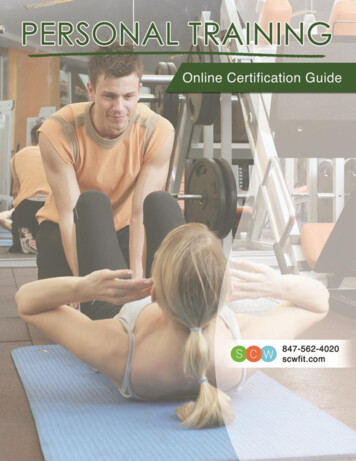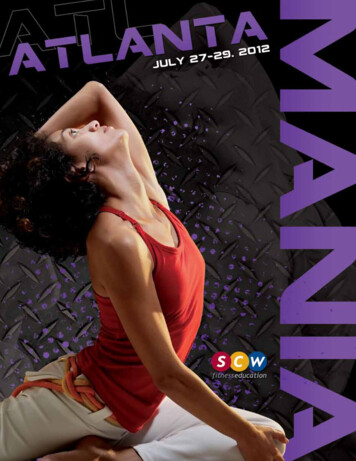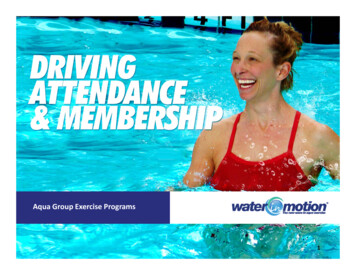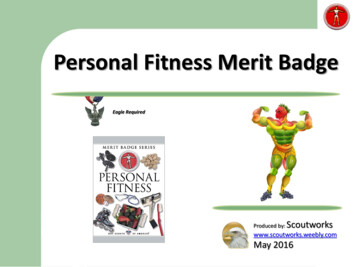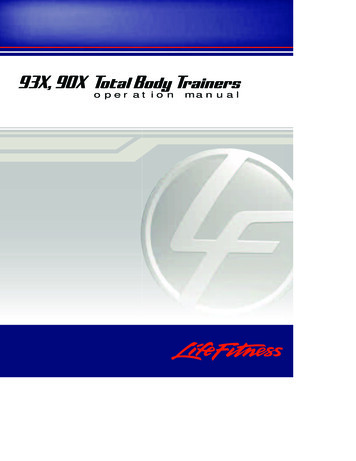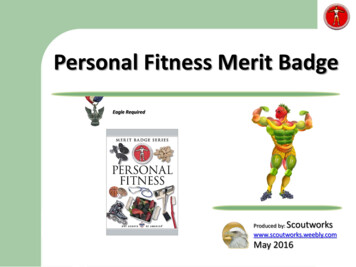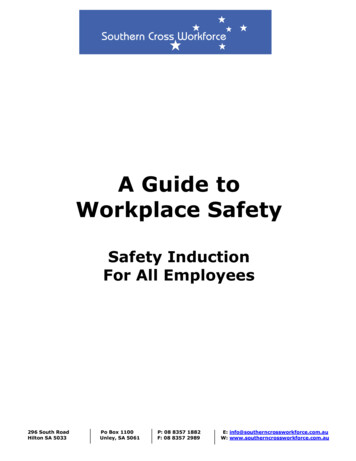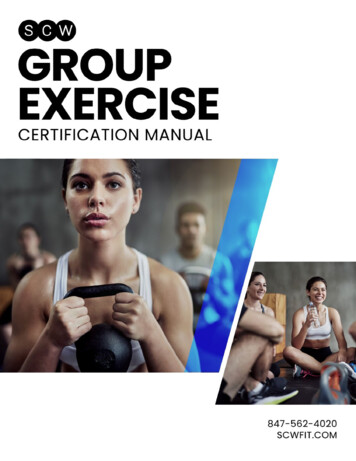
Transcription
SCW Nationally Recognized CertificationsSCW Fitness Education is a nationally recognized certification organization that has trained over100,000 Fitness Professionals. Our certifications are recognized by fitness facilities across theUSA and Internationally. The SCW Fitness Education Certifications are both general and specialtyin orientation and span from Group Ex, PT, Aqua, Yoga, Barre, Pilates, Sports Nutrition, WeightManagement, Kettle Weights and more. Each certification is developed and lead by qualified,veteran trainers that have 20 years of fitness experience. Theory, practice, and application combineto credential our SCW professionals and prepare them for quality instruction at large, small andspecialty facilities.Most SCW Online Certifications are presented live at each of our SCW MANIA conventions. Whenoffered, our live certifications are free (within one year) for those who have completed the courses.SCW Fitness EducationSCW is an internationally recognized education body that provides hands-on certifications andcontinuing education courses and conventions to fitness professionals in multiple disciplinesnationwide. For the past 35 years, since 1987, Personal Trainers, Group Exercise Instructors, SmallGroup Training Leaders, Aquatic Exercise Professionals, Cycling Teachers, Mind-Body Experts, SportSpecific Training Educators and many more get certified through SCW. This outstanding Family ofLeaders also supports Managers, Directors and Owners of clubs and facilities nationwide. As thelargest Conference Leader and Continuing Education Provider in the world, MANIA offers sevenProfessional Training Conventions in California, Florida, Atlanta, Dallas, DC, Midwest (Chicago), andBoston serving over 10,000 health and wellness professionals and reaching over 90,000 virtually.SCW Certifications Published bySCW Fitness Education 151 Pfingsten RdUnit PDeerfield, IL 60015847-562-4020www.scwfit.comCopyright 2015 by SCW Fitness Education.All rights reserved. No part of this publication may be reproduced or distributed in any form orby any means, or stored in a database or retrieval system, without the written permission of thepublisher. SCW Fitness Education logo and all images on covers and herein are the property of thepublisher and cannot be reproduced without prior written approval from the publisherDisclaimer:The authors and publisher of this material are NOT RESPONSIBLE in any manner whatsoever for anyinjury which may occur through reading or following the instructions in this manual.Last Edited: April 9, 2021 11:17 AM SCW Group Exercise Cer tification Intro Page 2
Table of ContentsCourse Introductionp. 4Chapter 1: Who is the Group Fitness Instructor?p. 5Chapter 2: Basic Body Alignment & Posturep. 7-12Chapter 3: Basic Anatomy & Physiologyp. 13-15Chapter 4: Class Foundationsp. 16-18Chapter 5: Safety and Injury Preventionp. 19-21Chapter 6: Class Structure : 3 Phasesp. 22-26Chapter 7: Intensity, Frequency,and ACSM Guidelinesp. 27-30Chapter 8: Creating Movementp. 31-33Chapter 9: Cueingp. 34-37Chapter 10: Musicp. 38-42Chapter 11: Muscular Strengthand Endurance Chapterp. 43-50Chapter 12: Flexibility andMind-Body Programmingp. 51-55Chapter 13: Group Exercise in theNew Virtual Worldp. 56-62Appendix A – Legal Issues for Fitness Prosp. 63-72Sample Formsp. 73-76Appendix B – Frequently Asked Questionsp. 77-78Appendix C – Leadership andProfessionalism Tipsp. 79Appendix D – Calculating Target Heart RangeUsing the Karvonen Methodp. 80-81Appendix E – Resourcesp. 82 SCW Group Exercise Cer tification Intro Page 3
COURSEINTRODUCTIONWELCOME to the SCW Fitness Education’s Group Exercise Certification course! Whether you are acurrent fitness professional who wants to begin teaching classes or simply a fitness enthusiast,our certification program is a comprehensive and effective way to learn how to lead group exerciseclasses. No previous teaching experience is necessary.Certification is important because it provides Instructors with a recognized standard of competencyfor teaching group exercise classes. While challenging, this course is basic enough for beginningGroup Fitness Instructors (GFI). It relies on current, sourced information for exercise science whilecombining applicable teaching skills and techniques.This course will focus on BENEFITS over RISKS, bringing an EFFECTIVE and SAFE experience for allparticipants. Creativity and motivation will prove to be important qualities in your career as a groupfitness leader, but understanding the risks and benefits associated with instructing a class shouldbe first and foremost.This course will prepare participants to train apparently healthy adults with no special limitations,needs, or physical issues, and does not include children, the elderly or pre or post- natal clients. SCWoffers courses for training special populations, including Aquatics, Active Aging, and Pregnancy(“Moms in Motion”). Part of every Instructor’s goal is to be able to progress and regress (advanceand modify) moves to make everyone with different abilities or challenges feel successful. Studentsmay come to class for a variety of reasons, which include, time of day, Instructor reputation, orchildcare options. This mix of attendees causes a need for multi-level instruction. Our premisefor this course is that today’s Group Exercise Instructors will be teaching multi- level classes for avariety of skill levels.Instructors completing this course: Can create and teach multi-level classes that are safe and effective Can effectively demonstrate and communicate how to perform specific movements Will have the knowledge progress/regress movements for participants Will be able to address specific injuries or health conditions and make generalrecommendations Know terminology relating to basic anatomyUnderstand how people learn in a group settingHave techniques to motivate & connect with participants in a group settingLead a variety of group class formats and sizesUnderstand the various components and responsibilities needed to be a GFI SCW Group Exercise Cer tification Course Introduction Page 4
CHAPTER 1Who is the GroupFitness Instructor?Group fitness instructors need to possess the ability to develop relationships of mutualunderstanding and trust through clear and concise communication. They should also have apassion for exercise and helping people, accompanied with the knowledge of how to effectively andsafely teach and modify movements for a variety of individuals, abilities, and levels.Generally, GFIs are highly motivated, extroverted professionals who are experts at helping classparticipants reach or even exceed at reaching their fitness goals. GFIs may teach many types ofexercise that include, cycling, weight lifting, yoga, aqua workouts, core and functional training. Classparticipants may consist of young, active aging, multi-lingual, and special populations all in oneroom. Each individual needs to be treated with respect and made to feel included and successful.The Department of Labor (DOL), Bureau of Labor Statistics (2010) states that “group exerciseinstructors are responsible for ensuring that their classes are motivating, safe, and challenging, yetnot too difficult for participants.”Responsibilities of a GFI: Deliver exercise classes and workshops Be a part of the group fitness team and its responsibilities Be a part of the facility team, assisting in activities that may include cleaning, emergencies, clubevents, communication, and safety measures Interact with all members and staff in a professional mannerMaintaining a certain level of physical fitness in order to execute classes in a safe and effectivemanner Maintain and demonstrate responsible attitudes toward all aspects of health and wellness SCW Group Exercise Cer tification C hapter 1: Who is the Group Fitness Instructor? Page 5
Scope of Practice of a GFI:CANCANNOTTeach and motivate group exercise classesDiagnose injuries or conditionsDemo proper alignment and techniquePrescribe exercise programsEmpower individuals and provide feedbackPrescribe or design nutrition plansAct with professionalism and maintainparticipant confidentialityRehabilitate or monitor medically referredclientsRecognize the scope of practice and refer whenappropriateCounsel individualsBe prepared to respond to emergenciesTreat a disease or injuryAssess the class environment before, during,and after class and report issuesAct outside the scope of practice for a GFICurrently, there is no law stating that you must hold a certification or degree to instruct a groupfitness class, however, most fitness facilities will require some type of certification including acurrent CPR card as a prerequisite to employment. SCW certifications are valid for two from the dateof completion but can easily be renewed by earning a minimum for 20 continuing education credits(CECs). SCW Group Exercise Cer tification C hapter 1: Who is the Group Fitness Instructor? Page 6
CHAPTER 2Basic Body Alignment& PosturesInstructors cue their students in and out of many body positions through a lot of movements,but the main body positions in group fitness consist of ten basic postures. A most importantconsideration for understanding safety and stability in group exercise classes is the spine, whichis divided into five sections. Our bodies are meant to move through three planes of movement andshould be included in each group fitness class.To keep our learning goals of “safe and effective” training along with “successful” classes forparticipants, we begin from the perspective of class design integrity with significant attention paidto the human bodies’ various postures, movements and planes of motion.10 BODY POSTURESPlease keep in mind that most body movements in group fitness classes originate from tenpositions. To coach the proper alignment for these postures, we need to understand setting up thebody from the point of view of contact points (with floor or wall) and joint alignment.When setting up any of the 10 positions of the body, cueing first what contacts the surface area(usually the floor, but it can be a mat or piece of small equipment, for example) helps promotesuccess from the start. Stability is key and it is based upon this foundation.Note the following positions shown in the diagram below, and where a contact point is made:POSITIONPOSITIONSTANDINGHINGINGFeet / Floor SCW Group Exercise Cer tificationFeet / Floor Chapter 2: Basic Body Alignment & Postures Page 7
INESIDE-LYING & SIDE PLANKFoot & Knee / FloorGluteals / FloorPosterior Body / Floor or other object SCW Group Exercise Cer tification Elbow & Hip / FloorChapter 2: Basic Body Alignment & Postures Page 8
POSITIONPOSITIONPRONEALL 4’S / TABLETOPPOSITIONPOSITIONPLANKREVERSE PLANK / V- SITAnterior / FloorHands, Knees, & Feet / FloorHands & Toes / Floor SCW Group Exercise Cer tificationHands & Feet / Floor Chapter 2: Basic Body Alignment & Postures Page 9
ALIGNMENTThe body is “in alignment” when the major joints follow symmetrical patterns between the two sides,and/or display vertical alignment with no twisting. Cueing the alignment of the major joints of thebody (with some additional physical landmarks, for example, direction of toes) promotes stabilitybefore adding mobility. “Stability before mobility” is a teaching approach favored in therapeutic andexercise science communities and the SCW certification courses.The major joints are:Ankles, knees, hips, elbows, shoulders, neck, and wrists. Additional cueing that might accompanyjoint alignment includes pelvic floor and transverse abdominus contraction.NEUTRALThe body is in “neutral” when the joints line up with the ears, the ribs and the hip connection is fixed(not soft) and the bowl-shaped bones of the pelvis, front and back, are in alignment. Movementduring class may take the body out of neutral, but should never take it out of alignment. The spine isin a neutral position when it is naturally EXTENDED.ExampleWhen standing tall with good posture, the body’s joints line up in one line, which creates alignment.The body is in NEUTRAL. If we flex the knees and put our hands on the quadriceps and round ourbacks, we are no longer in neutral, but we are still in alignment. To maintain a safe environment,Instructors should coach and demonstrate NEUTRAL and ALIGNMENT as much as possible.Deviations from NEUTRALWhen standing, sometimes the muscles in the upper front of the body pull too strongly andoverstretch the muscles in the upper back and shoulders, resulting in forward head posture and anupper flexion of the spine.This is called KYPHOSIS. Whenever the muscles in the lower back pull the pelvis towards the back,this condition is known as LORDOSIS. A spine that appears “S” shaped usually indicates a conditioncalled SCOLOIOSIS.Although instructors should not diagnose these deviations from proper postural alignment, theyshould be able to recognize the characteristics associated with them.Giving cues for proper postural alignment and posture such as, “make sure your shoulders aresqueezing back and in toward your spine and you knees remain relaxed during class.” SCW Group Exercise Cer tification Chapter 2: Basic Body Alignment & Postures Page 10
Above: The first photo illustrates a kyphotic stance while the second photo illustrates a lordoticstance, and the third photo features a neutral alignment.5 SECTIONS OF THE SPINEThe healthy spine is extended and neutral but not straight. Each section has a small, normal curve.When the curves become exaggerated, these are unnatural deviations.Instead of “sit up straight”, Instructor terminology should reflect a more realistic approach to spinalstability while encouraginga neutral spine with words such as “lifted”, “extended”, and “elongated”.4 SPINAL MOVEMENTSFlexion: Decreasing the angle or space between bones.Extension: Increasing the angle or space between bones.Rotation: Medial (inward) or lateral (outward) turning about the vertical axis.Lateral Flexion: Flexion (see right) laterally (to one side of the body). SCW Group Exercise Cer tification Chapter 2: Basic Body Alignment & Postures Page 11
3 PLANES OF MOVEMENTExercise movements occur from the 10 body positions in a variety of possibilities, but all movementoccurs in only three planes in space. SAGITTAL PLANE: space for moving forward and backward (seen from the side), pushing andpulling, often with FLEXION and EXTENSION FRONTAL PLANE: space for moving side to side (can be easily seen from the front) and oftenwith abduction and adduction TRANSVERSE PLANE: space for moving across and around, sweeping or twisting across thebodyInstructors should consider using movements during the MOVEMENT PREPARATION that providespinal attention and body movement in the following order: sagittal, frontal, transverse planesSagittal PlaneFrontal PlaneTransverse Plane SCW Group Exercise Cer tification Chapter 2: Basic Body Alignment & Postures Page 12
CHAPTER 3Basic Anatomy &PhysiologyGFIs should be familiar with the basic skeletal names of the body, major muscles, joint actions, andcommon movements when they are used. This will not only create validity and credibility to theinstructor, but also help to educate class participants on the “feels” as the instructor delivers cuesfor body focus and postural alignment.Diagrams 1 and 2 below show the major bones and muscles of the human body that will be mostcommonly referred to in most group fitness classes.Diagram 1: SCW Group Exercise Cer tification Chapter 3: Basic Anatomy & Physiology Page 13
Diagram 22 TYPES OF MUSCLE CONTRACTIONSIsometric: A contraction in which there is no change in the angle of the involved joint (absence ofjoint movement) and little or no change in the length of the contracting muscle. EXAMPLE: Hold apush-up position or prone plank.Isotonic: A contraction in which a muscle changes length against a force resulting in movement;a constant load (for example, a dumbbell or body) is moved through a range of motion of theinvolved joint. Within an isotonic contraction, there are two phases: concentric (shortening/tensionincreases) and eccentric (lengthening/tension releases). EXAMPLE: In your push-up, on the downphase, it’s eccentric: your chest is stretching. During the up phase, it’s concentric as the pecsshorten and tension must increase to push your body back up against gravity.See pages 43-44 for a more detailed diagram of the muscle anatomyJOINTS OF THE BODYThe major joints are: ankles, knees, hips, elbows, shoulders, neck, and wrists. Additional cueing thatmight accompany joint alignment includes pelvic floor and transverse abdominus contraction.Joint actions: SCW Group Exercise Cer tification Chapter 3: Basic Anatomy & Physiology Page 14
Flexion-refers to the bending of a jointExtension-refers to straightening a jointAbduction-movement away from the midline of the bodyAdduction-movement towards the midline of the bodyRotation-a circular movement (of a limb) around a fixed joint towards or away from the midlineof the body SCW Group Exercise Cer tification Chapter 3: Basic Anatomy & Physiology Page 15
CHAPTER 4ClassFoundationsCLASS ELEMENTSAlmost every type of group exercise class today can be categorized as having one of three mainpurposes, called “elements” (modality), which are:1. Cardiovascular2. Strength3. FlexibilityWhile you, as the instructor, may not teach a variety of modalities, it is important for the healthand safety of your participants to recommend incorporating all three class elements into a regularroutine. You may need to educate them on each element and assist them in developing a schedulethat is feasible to achieve.Traditionally, research supports classes that have a more traditional plan: cardiovascular beforestrength followed by flexibility. However, today’s group exercise classes have evolved into manydifferent formats that include putting strength before cardio, followed by flexibility or even yogaposes combined with cardio segments. Class formats that mix a combination of modalities are alsopopular such as BootCamp style classes or other fusion formats.Fusion: When there is a combination of two or more of the following modes, the industry terms thisa fusion class. Examples might be “Step and Sculpt” or “Aqua Circuit”, for example, because there isa fusion of strength/endurance and cardiovascular conditioning. When there is only one mode—orpurpose—but a combination of approaches, this is another type of fusion class.For instance, cardiovascular training is the only mode in a “Cardio Circuit” class, but it can be afusion of approaches, consisting of trampoline jumping, jump-ropes, and dance.TYPES OF CARDIO:Regardless of the type of class you may be teaching, the GFI should understand the followingconcepts and terminology:Steady State:If we maintain workout intensity at a steady level for the majority of a class, thisis called steady state training. Examples of steady state training would be walking, ellipticalmachines, low impact cardio, and rowing machines. SCW Group Exercise Cer tification Chapter 4: Class Foundations Page 16
Interval:If we raise and lower this intensity, this is called interval training. Examples of common intervaltraining classes are Tabata, H.I.I.T., Bootcamp, and indoor cycling programs.Fitness Instructors should address breathing at various intervals during class.Proper breathing is a clue to participants’ levels of exertion and supports their movements withoxygen intake.Aerobic:Another term related to breath is Aerobic, which is derived from the meaning “in the presence ofoxygen”. In all states of being alive, even when we are sleeping, we are “aerobic,” but not necessarilyinvolved in “aerobic conditioning”. Aerobic exercise means activities that allow the free conversionof oxygen in the air, through the lungs, into the blood and muscles of the body— such as climbing,walking, running and dancing.Anaerobic:Conversely, anaerobic exercise is that which requires more oxygen than is available for the body totake in and convert for use inside the working muscle. The body therefore breaks down other storedenergy sources such as glycogen (stored carbohydrates) or ATP. Weight training for strength orpower is considered anaerobic as is most concentrated work against heavy loads.ENERGY SYSTEMS:Adenosine Triphosphate (ATP) is considered the body’s energy currency. ATP is a high-energy compound stored in our cells and is the source of all energy used at restand during exercise. ATP is used to build molecules, contract muscles, generate electrical impulses and convert theenergy found in food to power our bodies and brains. ATP consists of a molecule of Adenine (a protein) and Ribose (a sugar) - forms Adenosine,linked to three phosphate molecules. Two outermost phosphate bonds are high-energy bonds containing the stored energy withinATP. Work is possible by splitting the outermost high-energy bond from ATP releasing 7.3 kilocaloriesof energy, which does not require oxygen. At rest the body expends approximately 1.0 - 1.3 kcal/min (only 20% used by skeletal muscle)whereas during heavy exercise the body can expend 20 - 25 kcal/min ( 80% used byskeletalmuscle).THE TWO ENERGY PATHWAYS:The body contains two energy pathways: Aerobic and Anaerobic.Aerobic (oxidative) pathway contributes most significantly to our energy needs; requires oxygen,generates energy at slower rates, and can use carbohydrates, fats and proteins as a fuel. SCW Group Exercise Cer tification Chapter 4: Class Foundations Page 17
Anaerobic pathways provide limited, more rapid energy; use ONLY carbohydrates as a fuel andprovides energy when: Additional energy is needed when intensities exceed the capacity of the aerobic pathway.Immediate energy is needed during any increase/change in activity or exercise intensity.When aerobic stores cannot supply the energy needed to fuel the increased capacity of thepathway, it is called the “anaerobic threshold,” which is the level at which the body burns storedsugars to help meet the demands placed on it, and produces lactic acid faster than it is clearedaway.Within the anaerobic pathways:ATP-PCR system (phosphagen system) creates energy for the body’s most immediate needs, butalso generates the least amount of energy ( 10 seconds of all-out effort).Glycolytic (anaerobic glycolysis) system takes over the as phosphagen system becomes depleted andgenerates a larger amount of energy.DURATIONKeep in mind that there is no set class length. Introductory classes may be 15 minutes in length,such as “Intro to Yoga Breathing” or “Pre-Race Warm-Ups”. Thirty minute classes are popular as theyaddress the number one reason why many people claim that they donot take group ex. classes; lack of time (Perrottet). Forty-five minute class formats became popularwith the onset of indoor cycling. Fifty to fifty-five minute classes are popular because they alsoallow for the transition time between classes, which enables one Instructor to finish his/her classwhile another Instructor prepares the equipment and other room needs (temperature, lighting,music, etc.)INTENSITYThe level at which class participants work can usually be safely adjusted with the right instructionand their own awareness. However, many classes are of a general intensity by nature, dependingon class type. Many factors affect exercise intensity, which range from load, reps, and rest betweensets to class duration, range of motion, or even beats per minute (bpm). Planning for intensityprogression & regression is essential and fully covered in Chapter 6.SAFETY PRECAUTIONSSafety cannot be overstated as a goal for fitness Instructors and a specific element of groupexercise programs. Chapter 5 discusses numerous approaches to safety and injury prevention forSCW Group Exercise Certification Candidates. SCW Group Exercise Cer tification Chapter 4: Class Foundations Page 18
CHAPTER 5Safety & InjuryPreventionPreventing exercise-related injuries is one of our primary responsibilities as Group ExerciseInstructors. We want to teach fun and effective classes, but above all, they should be safe! Most ofthe injuries sustained in group exercise classes are mild and do notrequire medical treatment, but keeping our participants injury-free should be our goal! We also needto keep ourselves safe as well.10 SUGGESTIONS FOR SAFETY:1. Think of the body’s alignment, symmetry, and support in all positions considering the joints andears and lower back:EARS SHOULDERS ELBOWS HIPS LUMBAR AREA KNEES ANKLES TOES2. Protect the spine internally and externally whenever possible, especially with new participants.3. Emphasize control of movement over the number of repetitions and competition.4. For non severe injuries recommend mild movement to jump-start the healing process beforeseeking medical attention.5. Balance work for both sides of the body to promote overall muscular balance and reducemechanical stress.6. Remind participants about the importance of hydration and encourage them to drink water (or adiluted sports drink if they prefer) before, during, and after class.7. Consider classroom space, layout, floor and equipment condition and proper usage carefully.8. Keep music volumes at reasonably low levels (less than 90 decibels if measurement is possible)and keep the beats per minute appropriate to the discipline.9. Keep CPR and AED certifications current. Know your facility’s emergency procedures and how torespond it necessary.10. Use robust verbal and visual cueing to ensure that the highest percentage of learners in classcan follow. SCW Group Exercise Cer tification Chapter 5: Safety & Injur y Prevention Page 19
10 SUGGESTIONS FOR INJURY PREVENTION AND INSTRUCTORSELF-CARE:1. Invest in a good pair of shoes designed for teaching the types of activities specific to yourschedule. Many reported injuries in group exercise occur below the knee. A good pair of shoes canhelp absorb the impact forces and reduce the risk of injury. Barefoot programming requires specialeducation.2. Exercise on an appropriate floor. Suspended wood floors arebest for absorbing shock. If the floor is not wood, ensure that ithas adequate cushioning.3. Adhere to ACSM’s recommendations to avoid the OveruseSyndrome. Exercising too often, for too long or at too high of anintensity can manifest itself in such chronic injuries as musclestrains, tendonitis, stress fractures and bursitis.4. Vary your exercise activities and types of classes you teach.It is especially important to combine high impact activities withlow and non-impact activities.5. Ensure adequate hydration, especially in hot, humidenvironments. Try to consume enough water before, during, andafter class. Hint: “Enough hydration” produces light yellow urine,the color of lemonade.6. Encourage all students to attend the entire group exerciseclass. Arriving late and missing the warm-up dramaticallyincreases the risk for injury. Leaving early prior to the flexibilitysegment can result in tight, sore muscles and possiblemuscular imbalances.7. Teach only as much as necessary. In our pursuit of earning a living as a fitness professional, weoften teach too many classes. Be aware of the signs of over-training: fatigue, anemia, weight loss,unusual changes in resting and recovery heart rates, chronic pain and any of the injuries listed innumber three above. Try to teach a variety of class types and formats.8. Protect your voice. Teach with a microphone whenever possible and speak in a normal voice. Ifa microphone is unavailable, play the music at a level that does not require you to yell to be heard.Take frequent sips of water during class to keep your vocal cords lubricated. Avoid frequentlyclearing your throat.9. Teach according to your preparation. If you want to teach with specialty equipment, seekspecialty training for that equipment. Ignorance of proper form and technique places both you andyour students at risk.10. Learn the benefits of self-myofascial release with small balls or foam rollers to help take care ofthe muscles & connective tissue. SCW Group Exercise Cer tification Chapter 5: Safety & Injur y Prevention Page 20
SPECIAL POPULATIONSAs a fitness instructor, you will most likely encounter participants who may require accommodationsbeyond your scope of practice. Make sure to avoid making recommendations for those individualswho do not have medical clearance or are working under a doctor’s care. Special populations mayinclude: PregnancyDiabeticObesityArthritisIf these participants have medical clearance, be sure to include appropriate options, regressions andaccommodations as needed SCW Group Exercise Cer tification Chapter 5: Safety & Injur y Prevention Page 21
CHAPTER 6Class Structure:3 Class PhasesCreating a multi-level structure includes organizing it around progressions and regressions foreveryone who might be in attendance. To increase or decrease the overall intensity of moves,Instructors can implement the acronym D.R.I.L.L.S coined from Sara Kooperman.Instructors can define almost every progression and regression from this acronym, from warm-up tocool down in nearly every type and modality of Group Exercise.D: DIRECTION (usually anything other than standing still facing forward makes a progression)R: RANGE OF MOTION, REPETITIONS, AND RHYTHM (increasing rhythm makes a progression,except for strength/endurance training)Cardio: (e.g. jumping jacks) faster usually is a progressionStrength/Endurance: (e.g., pushups) slower is usually is a progressionRange of Motion and repetition are ways to alter intensity: increasing reps and/or range of motiongenerally progresses a movementI: INTENSITY AND IMPACT (intensity and impact are not always related; “impact” simply refers tovertical impact forces on the body when removing the feet from their surface. “High impact” occurswhen both feet
SCW Group Exercise Certification Intro Page 2 SCW Nationally Recognized Certifications SCW Fitness Education is a nationally recognized certification organization that has trained over 100,000 Fitness Professionals. Our certifications are recognized by fitnes

